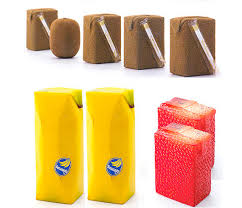Package Design: Is it a growing field?
 Package design is an important part of product brand management that requires practitioners to exercise graphic design and marketing skills. Consumable goods manufacturers often face heavy competition from the makers of similar products on the market. When it is not feasible to adopt a low price strategy to protect its market share, a business may rely on innovative product packaging to help differentiate its goods. Here are some of the activities that are typically performed by package designers, a common career path to becoming a package designer and the job outlook for the career field.
Package design is an important part of product brand management that requires practitioners to exercise graphic design and marketing skills. Consumable goods manufacturers often face heavy competition from the makers of similar products on the market. When it is not feasible to adopt a low price strategy to protect its market share, a business may rely on innovative product packaging to help differentiate its goods. Here are some of the activities that are typically performed by package designers, a common career path to becoming a package designer and the job outlook for the career field.
Activities Performed by Package Designers
Product packaging directly drives sales, and the effort to create effective packaging is extensive. Designers must conduct analysis of the given product, the distribution channels used and consumer preferences of the target market before they can begin to apply their creative talents for a proposed prototype. For example, designers assess ways that consumers must use a product and create practical package designs to help facilitate ease of use. Companies hope that customers will eventually recognize the convenient packaging features and choose to buy their products over those that belong to similar brands. Environmental awareness increasingly influences packaging decisions, and many consumers often reward company brands for choosing product packaging that is made from sustainable materials. Also, packaging materials and efficient design elements are important when companies negotiate with distributors; product manufacturers that utilize low weight or space saving packaging gain more favorable terms with distributors and retailers. Understanding consumer trends and the target market associated with a branded product are essential for the creation of innovative package designs that increase sales. While knowledge of trends is important, there are some product packaging considerations that remain constant. For instance, packaging should always portray the product honestly, be flexible enough to fit extended product lines and transparent enough to enable prospective customers to identify the product type and brand immediately.
Starting a Career as a Package Designer
Many package designers are introduced to the career field as undergraduate graphic design students, and some academic programs in graphic design allow students to concentrate in product packaging design as a major. The course work and projects within this academic discipline expose students to design principles, standard color theory, imagery and typography. Students who know that they want to apply their graphic design skills to the field of product packaging often take minors in marketing or gain professional knowledge on the subject through certification programs. During their time as students, these future designers usually build up portfolios of their work from class projects and supervised internships. The skills of package designers are unique, and successful designers have technical and business knowledge that can be taught as well as special creative abilities that must be developed. Besides demonstrating their talents through design portfolios, many designers join professional organizations for continued professional development and networking opportunities.
Job Outlook for Package Designers
Package designers typically gain employment with packaging design agencies directly, or they work as freelance designers. According to the Bureau of Labor Statistics (BLS), packaging design is a subcategory of the graphic design labor category, and the BLS projects slow growth for careers in graphic design. While jobs exist in the career field, designers are expected to face heavy competition in the job market.
Conclusion
Most people are not conscious of the importance of a product’s packaging unless it causes some kind of inconvenience to them. However, a great deal of creative and technical work goes into package design that performs functionally, esthetically and sustainably.
Related Resources: